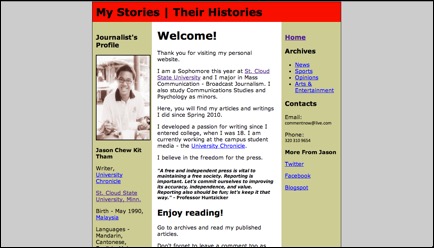"Rhetorical Web Design: Thinking Critically about Ready-Made Web Templates and the Problem of Ease"
|
Jason ThamJason Tham is a PhD student in the Rhetoric and Scientific and Technical Communication program at the University of Minnesota in Twin Cities. His current research includes connected knowledge making and sharing, digital and visual rhetorics, and new inventions in writing and communication technology. His scholarly works have appeared in Journalism & Mass Communication Quarterly, Intercom, and Digital America: Journal of Digital Culture and American Life. ContentsOf Ease & Efficiency: The Problem with Template-Driven Web Designs Agency, Techne, and Extreme Usability Agency, Techne, and Extreme Usability Analysis of a Template: WordPress.com |
Works CitedAriga, T., & Watanabe, T. (2008). Teaching materials to enhance the visual expression of web pages for students not in art or design majors. Computers & Education, 51(2), 815-828. Arola, K. (2010). The design of web 2.0: The rise of the template, the fall of design. Computers and Composition, 27, 4-14. Bernhardt, S.A. (2013). Rhetorical technologies, technological rhetorics. College Composition and Communication, 64(4), 704-720. Coalo, J.J. (2012). With 60 million websites, WordPress rules the web. So where’s the money? Forbes. Retrieved April 6, 2014. http://www.forbes.com/sites/jjcolao/2012/09/05/the-internets-mother-tongue/ Dilger, B. (2007). Extreme usability and technical communication. In J.B. Scott, B. Longo, & K.V. Wills (Eds.), Critical Power Tools: Technical Communication and Cultural Studies (47-69). New York: SUNY Press. Gallagher, J. (2015). The rhetorical template. Computers and Composition, 35, 1-11. Hocks, M.E. (2003). Understanding visual rhetoric in digital writing environments. College Composition and Communication, 54(4), 629-656. Hsu, C., & Shiau, H-C. (2013). The visual web user interface design in augmented reality technology. International Journal of Advanced Computer Science and Applications, 4(2), 116-121. Johnson, R. (2010). Craft knowledge: Of disciplinarity in writing studies. College Composition and Communication, 61(4), 673-690. Karper, E. (2005). “Ordinary people do this”: Rhetorical examinations of novice web design. Business Communication Quarterly, 68(3), 340-344. Kostelnick, C. (1996). Supra-textual design: The visual rhetoric of whole documents. Technical Communication Quarterly, 5(1), 9-33. Krug, S. (2005). Don’t Make Me Think. Berkeley: New Riders Press. LeBlanc, P. (1990). Competing ideologies in software design for computer-aided instruction. Computers and Composition, 7(2), 7–19. Lin, C. (2007). Organizational website design as a rhetorical situation. IEEE Transactions on Professional Communication, 50(1), 35-44. Lindsley, T. (2013). Prefab interface development and the problem of ease. Communication Design Quarterly, 1(2), 37-49. Mejia, G. & Chu, S. (2014). A model for visual communication design: Connecting theories of rhetoric, literacy, and design. The Design Journal, 17(1), 29-43. Norman, D. (1990). The Design of Everyday Things. New York: Basic Books. Online Course Report. (2016). The 50 most popular MOOCs of all time. Onlinecoursereport.com. Retrieved January 10, 2016. http://www.onlinecoursereport.com/the-50-most-popular-moocs-of-all-time/ Peak, D., Prybutok, V., Gibson, M. Wu, Y., & Xu, C. (2014). User perceptions of aesthetic visual design variables within the informing environment: A web-based experiment. Informing Science: the International Journal of an Emerging Transdiscipline, 17, 25-57. Richards, A.R., & David, C. (2005). Decorative color as a rhetorical enhancement on the World Wide Web. Technical Communication Quarterly, 14(1), 31-48. Robins, D., Holmes, J., & Stansbury, M. (2010). Consumer health information on the Web: The relationship of visual design and perceptions of credibility. Journal of the American Society for Information Science and Technology, 61(1), 13-29. Rosenquist, C. (2012). Visual form, ethics, and a typology of purpose: Teaching effective information design. Business Communication Quarterly, 75(1), 45-60. Salvo, M. (2012). Visual rhetoric and big data: Design of future communication. Communication Design Quarterly, 1(1), 37-40. Selfe, C., & Selfe, R. (1994). Politics of the interface: Power and its exercise in electronic contact zones. College Composition and Communication, 45(4), 480-504. Sullivan, P. (2001). Practicing safe visual rhetoric on the World Wide Web. Computers and Composition, 18(2), 103-121. Taylor, P. (1992). Evaluating software: What Thoreau said to the designer. Computers and Composition, 9(1), 45–52. Turnley, M. (2005). Contextualized design: Teaching critical approaches to web authoring through redesign projects. Computers and Composition, 22(2), 131-148. Wortham, J. (2012). A surge in learning the language of the internet. New York Times. Retrieved April 6, 2014. http://www.nytimes.com/2012/03/28/technology/for-an-edge-on-the-internet-computer-code-gains-a-following.html?pagewanted=all Wysocki, A.F., & Jasken, J.I. (2004). What should be an unforgettable face.... Computers and Composition, 21(1), 29–48. |
|
Jason ThamJason Tham is a PhD student in the Rhetoric and Scientific and Technical Communication program at the University of Minnesota in Twin Cities. His current research includes connected knowledge making and sharing, digital and visual rhetorics, and new inventions in writing and communication technology. His scholarly works have appeared in Journalism & Mass Communication Quarterly, Intercom, and Digital America: Journal of Digital Culture and American Life. ContentsOf Ease & Efficiency: The Problem with Template-Driven Web Designs Agency, Techne, and Extreme Usability Agency, Techne, and Extreme Usability Analysis of a Template: WordPress.com |
AppendicesAppendix 1 - My Amateurish Writing Portfolio Appendix 2 Link to site: http://studentweb.stcloudstate.edu/thja0905/COMM241%20webpage/homepage.html |